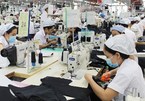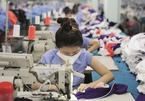The report, reviewing industrial production results in H1, showed that textile production in the first half of the year increased by 2.8 percent, or just one third of the same period last year.

Apparel production in June increased by 17.5 percent compared with May, but still fell by 5 percent compared with the same period last year.
Textile and garment companies confirmed their difficult situation, saying that orders were mostly cancelled in May and June, and tens of thousands of workers are in danger of losing their jobs.
The Vietnam Textile and Garment Group (Vinatex), the biggest producer, estimated that the industry might lose up to 50 percent of orders in May. The recovery of the supply sources in the context of demand may cause textile and garment prices in the world to decrease by 20 percent.
Struggling to survive the difficulties, many companies have changed their production processes and shifted to making other products that have higher sales during the Covid-19 period.
| As companies cannot get orders for high-end suits and shirts, they have shifted to make labor protective clothing, traditional knitwear and shirts. Some of them have also shifted to make cloth face masks for domestic consumption and export. |
As companies cannot get orders for high-end suits and shirts, they have shifted to make labor protective clothing, traditional knitwear and shirts.
Some of them have also shifted to make cloth face masks for domestic consumption and export.
According to MOIT, Vietnam’s major markets, including the US, South Korea, Japan and Europe, began loosening their social distancing policies at the end of Q2 and people’s shopping demand has begun increasing.
Some companies reported that they have begun exporting products under contracts they had signed before. MOIT hopes that export turnover will increase most sharply in the last months of the year, when demand increases on Christmas and the New Year holiday.
Like the textile and garment industry, the footwear industry saw export turnover decrease by 6.7 percent in H1 compared with the same period last year.
Vinatex predicted that 50,000 workers may be laid off as a result of the pandemic. it is the leading company in the textile and garment industry, owning 200 factories and employing 100,000 workers. It is also the supply chain of well known fashion brands, including Zara and H&M.
Zing.vn on July 8 cited a report of the General Statistics Office (GSO) as showing that the turnover of textile companies dropped by 61.6 percent in the first four months of the year and the figure was 78 percent for garment companies.
Meanwhile, onlly 133 companies, or 3.6 percent of surveyed companies, said they have received support. Fifty percent of businesses have scaled down production, and 35 percent have downsized their workforce.
Chi Mai

Vietnam's garment industry yet to enjoy benefits from EVFTA
It is anticipated that local textile and apparel firms will not be able to enjoy any immediate benefits from the European Union -Vietnam Free Trade Agreement (EVFTA) once it enters into force due to rules of origin, according to insiders.

Vietnamese textile and garment industry: difficulties still ahead
With demand decreasing sharply, the textile and garment industry is expected to continue facing difficulties in Q2.
 The lack of input materials and cancellations of 50 percent of orders have put textile and garment companies in serious difficulty, according to the Ministry of Industry and Trade (MOIT)." itemprop="description" />
The lack of input materials and cancellations of 50 percent of orders have put textile and garment companies in serious difficulty, according to the Ministry of Industry and Trade (MOIT)." itemprop="description" />